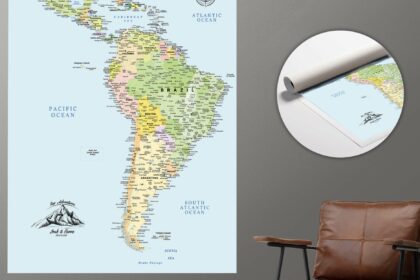
Article Highlights
What we can learn from asking of South and Central America
You’re failing. Let me cut to that chase. After more nearly two decades in Austin, Texas, and working with cities and regions throughout the world, what holds YOU and your economy back is that you won’t communicate clearly, distinguish your strengths, and acknowledge your weaknesses. I’ve asked the question repeatedly in my hometown, what specifically does Austin do well in startups, and the answers I get are not only haphazardly all over the place, but they’re also usually non-descript or ignorant: B2B, Enterprise Software, tech, or “we don’t do consumer”
Now, that is a rough sampling of merely my experience with Austin, so let me share with you an experiment I just completed.
I asked this on a half dozen different social networks where I then intentionally tagged people who work in economic development, run startup hubs, direct startup development organizations, or invest, “What are the distinct strengths and weaknesses of the startup ecosystem in your country? Seeking Central and South American countries in particular. Be sure that strengths are unique if you want to be featured; do not submit anything similar to what other countries typically highlight. You must also include weaknesses as the article is meant for organizations that might be able to overcome challenges. Do not refer to horizontals such as ‘tech’ as I’m seeing to understand better where investment in innovation there is best suited (that is, not tech, but for what??).”
All told, I tagged about 400 people over the past few weeks. Very few replied.
Already, without even sharing any of the replies, we have our first and most substantial insight to WHY your ecosystem is failing and what you can learn from this experiment.
No one took the opportunity merely to promote themselves, their work, and their opinion.
Is it that you don’t know? Is it fear of being wrong?
Why would people in your role in the economy in particular, not take every opportunity to promote your county, your region, your city, your hub, and your strengths?? Herein, handed to you to get attention and investor support, neglected.
You’re failing. Startup founders in particular can NOT afford to waste time, attention, and resources on the wrong places, while investors, in the same boat, moreover, will not afford to waste time where it isn’t clear that they should. So, while I hear from governments daily asking how they might better develop their startup ecosystem, the answer foremost is evident: speak up!
Argentina Thrives on Talent
Love this, here’s one I receive from Marco Genaro Palma, Freelance CMO & SEO Consultant, GenaroPalma.com, coincidentally (wonderfully so), just as I shared my own take on Argentina:
As I see it, Argentina’s startup ecosystem thrives on talent but struggles with economic hurdles. The country is known for its skilled tech professionals and innovative entrepreneurs, making it an attractive hub for talent sourcing. However, working with international clients is complicated due to strict currency controls, which limit access to foreign currencies like USD.
High taxes and unpredictable regulations add another layer of difficulty, forcing many entrepreneurs, including myself, to base operations outside the country.
While the talent pool is unmatched, the economic instability makes scaling globally from within Argentina a major challenge.
Marco is exactly right about the challenges and opportunities facing Argentina, and I want to applaud him for saying so, but we’re left wondering what strengths are unique to Argentina (respectfully, talent can be found everywhere).
South America at Large
Nick Esquivel, CEO of Globaltize draws us closer while also taking advantage of the opportunity (kudos!)
At Globaltize, we hire extensively from South America, particularly individuals who’ve previously attempted startups. This entrepreneurial talent brings unique strengths, like agility, resilience, and the ability to navigate resource-constrained environments-traits shaped by the startup ecosystems in their countries. Here’s a closer look at the strengths and weaknesses of startup ecosystems in South America:
Strengths:
1. Brazil: Boasts a massive domestic market, particularly in fintech and e-commerce, driven by digital adoption and innovative payment solutions like PIX.
2. Argentina: A strong tech talent pool with a history of successful unicorns (e.g., Mercado Libre), fueled by high-quality education in STEM fields.
3. Chile: Renowned for its government-backed programs like Start-Up Chile, which offer significant funding and support for early-stage ventures.
4. Colombia: Rapidly growing as a fintech hub with strong regional connectivity and increasing venture capital investment.
Weaknesses:
1. Brazil: Regulatory complexity and bureaucratic red tape can slow business operations and expansion.
2. Argentina: Economic instability, including inflation and currency fluctuations, creates challenges for scalability and investor confidence.
3. Chile: While startups thrive initially, scaling internationally is often limited by the small domestic market.
4. Colombia: Limited access to late-stage funding and mentorship for scaling up beyond local markets.
Globaltize helps address these challenges by connecting South American talent with global opportunities, allowing them to overcome domestic constraints and thrive in international roles. Their entrepreneurial spirit, paired with experience from diverse markets, enables them to contribute meaningfully to organizations worldwide.
Notice the distinctions that help us all? Fintech, ecommerce, education… answers are in there and I’m connecting with Nick now because he’s on the right track about what matters; that, we can uncover financially strengths and weaknesses pretty easily but if you think Money or Tech (generically) is the answer you’re seeking for your economy, you’re wrong. Here we have some insight to Brazil and Argentina that helps understand specifically what we might seek, support, or fund in those countries.
Being transparent about your strengths and weaknesses is CRITICAL to a vibrant startup ecosystem because the entrepreneurs need to know that if they step up and take risks, the advisors, investors, service providers, and potential partners, in the region, will be able to meaningfully help them, or not. If you’re unwilling to dismiss or discount what you don’t do well (which is typical of economic development or inexperienced service providers and investors — because they don’t want to lose an opportunity or disregard *something* that’s there), you’re actually hindering the ecosystem because you’re enabling the entrepreneurs to FAIL more frequently because of misinformation, inexperience, or mismatch.
Latin America Solves Local Problems
Jon Morgan, CEO, Business and Finance Expert at Venture Smarter shares, “Over the years, I’ve worked with several startups in Latin America, and I’ve seen firsthand both the strengths and weaknesses of the region’s startup ecosystem.
One of the key strengths of startups in Latin America is their ability to solve real, local problems. Entrepreneurs are highly focused on creating products and services that directly address challenges in the region, especially in sectors like fintech, edtech, and agritech. For example, in fintech, we’ve seen companies develop innovative solutions that help the unbanked, a large demographic in many countries across the region. This is something that sets the region apart, startups aren’t just focused on profitability but on creating tangible, positive change.
Another strength is the growing support for entrepreneurs. Government policies are slowly becoming more favorable, with programs offering incubators, grants, and accelerators. These programs are helping to nurture early-stage companies, which is vital for the region’s overall growth. There’s a lot of momentum right now in supporting startups and recognizing their role in driving economic growth and job creation.
However, there are weaknesses that can hold startups back. Access to capital remains one of the biggest challenges. While venture funding has been growing, it still lags behind what we see in more developed startup ecosystems like the US or Europe. Many startups rely on informal networks or bootstrap funding, which limits their ability to scale quickly. The risk appetite of investors in the region is often lower, meaning fewer startups are able to secure the funding they need.
Another weakness is the talent gap in key areas like technology and product development. Although the region has many talented individuals, there aren’t enough skilled tech professionals to meet the demands of growing startups. This often forces companies to either invest heavily in training or look for talent outside the region, both of which are costly and time-consuming.
Latin America’s startup ecosystem is full of potential, but it faces challenges, particularly around funding and talent. That said, there are clear signs of progress, and with continued support and investment, these obstacles can be overcome, paving the way for even more growth in the future.“
You Must EXCLUDE and Promote
Let me give you very brief examples from my own assessment of the countries in Central and South America.
Central America
Belize
- The country has a thriving tourism sector focused on eco-tourism and marine activities, thanks to its rich biodiversity and the Belize Barrier Reef, creating opportunities for sustainable hospitality innovation.
- Belize struggles with industrial development, particularly manufacturing and large-scale agriculture, which face challenges like limited infrastructure and workforce training.
Costa Rica
- Costa Rica excels in agriculture, particularly coffee and bananas, and is a global leader in sustainable and organic farming practices, making it an ideal ground for agritech solutions.
- The industrial sector is relatively weak, with limited heavy manufacturing and dependency on imported machinery.
El Salvador
- El Salvador has a robust textiles and apparel industry, bolstered by trade agreements like CAFTA-DR, positioning it as a hub for manufacturing innovations.
- The country’s lack of natural resources and mining capacity limits its industrial diversification, making these sectors particularly risky.
Guatemala
- Guatemala is a leader in coffee and cardamom production, leveraging its fertile highlands and diverse microclimates to dominate global markets in these agricultural goods.
- The energy and transportation sectors remain underdeveloped, with inconsistent electricity supply and poor road infrastructure deterring industrial growth.
Honduras
- Honduras has a strong agro-industrial base, particularly in the production of palm oil and bananas, which are globally competitive exports.
- Political instability and limited financial infrastructure create significant risks in banking and investment sectors.
Nicaragua
- Nicaragua has a burgeoning cattle ranching and beef export industry, alongside growing potential in its rum and tobacco production.
- The country’s energy sector is weak, relying heavily on imports and lacking renewable capacity to meet local demand.
Panama
- Panama’s strengths lie in logistics and global trade due to the Panama Canal, offering unique opportunities in shipping and port management innovation.
- The domestic agricultural sector is underdeveloped, with significant reliance on imported food products.
South America
Argentina
- Argentina’s agricultural sector, particularly its soybean and wine production, is globally renowned, creating demand for innovations in agro-industrial technology.
- The country’s mining industry is underutilized despite vast reserves, hindered by regulatory and political challenges.
Bolivia
- Bolivia holds one of the world’s largest reserves of lithium, positioning it as a key player in the future of battery materials and renewable energy applications.
- The manufacturing sector is weak, with most industries focused on small-scale production rather than large-scale industrialization.
Brazil
- Brazil dominates in agribusiness, particularly soybeans, sugarcane, and coffee, providing fertile ground for precision agriculture and biofuel innovations.
- Bureaucratic hurdles and high taxes make the retail and small business sectors risky and underdeveloped.
Chile
- Chile is a global leader in copper mining and export, which is central to its economy and offers opportunities in resource management technologies.
- The local automotive manufacturing and heavy industry sectors are underdeveloped, relying heavily on imports.
Colombia
- Colombia’s flower and coffee industries are key exports, supported by its favorable climate and logistics infrastructure for perishable goods.
- Security risks and limited infrastructure make large-scale industrial ventures in rural areas precarious.
Ecuador
- Ecuador excels in the export of bananas, shrimp, and cacao, supported by its favorable climate and strategic ports.
- The domestic manufacturing sector remains weak, with limited industrial diversification and competitiveness.
Paraguay
- Paraguay’s hydroelectric capacity, especially through the Itaipú Dam, is a major strength, offering renewable energy solutions to neighboring countries.
- The country’s weak financial systems and limited access to global markets hinder economic diversification.
Peru
- Peru is a leader in the mining of precious metals like gold and silver, providing opportunities for sustainable mining innovations.
- The lack of robust industrial infrastructure makes manufacturing and large-scale production challenging.
Uruguay
- Uruguay’s strength lies in its high-quality beef and wool exports, driven by its efficient livestock farming practices.
- The country’s reliance on a small domestic market limits opportunities for growth in large-scale industries.
Venezuela
- Venezuela has the world’s largest proven oil reserves, making energy exploration and extraction its primary economic strength.
- Diversified sectors like agriculture and manufacturing are nearly non-existent, hindered by economic mismanagement and political instability.
Understanding the distinct strengths and weaknesses of each country’s economy is critical for economists, economic development professionals, investors, and advisors because it allows them to allocate resources, develop strategies, and foster growth in ways that align with a nation’s intrinsic potential. Knowing these distinctions helps identify where innovation and investment can thrive—such as leveraging Panama’s logistical dominance or Bolivia’s lithium reserves—while also avoiding pitfalls like Guatemala’s weak infrastructure or Venezuela’s lack of diversification. This insight ensures that founders and startups are directed toward sectors where they can succeed rather than waste time and capital in risky or underdeveloped areas. When cities, governments, or other stakeholders fail to be explicit about these realities, they harm founders by creating false expectations, misallocating incentives, and undermining trust in the ecosystem. Transparency about strengths and weaknesses not only equips entrepreneurs to navigate challenges but also builds a robust foundation for sustainable economic development.



I’d like to share a story. We are still writing it but we know that innovation ecosystems create incredible value – but the early funding (and by default the early innovation) is often leaving its home region and finding a virtual home in markets that support economic development through smart permitting and policy and have private capital vehicles to seed early ideas at the right value and time.
Melissa Chalfant – have you seen different ecosystems tackle this topic?
Agreed. That is one thing that Puerto Rico definitely has, it’s just a matter of communicating those distinctions in a compelling manor. Once people experience what we have to offer they are normally hooked, or at least gain respect for what we have growing here.
Brian Bourgerie cheers that. I’d love your hot take on this:
https://seobrien.com/puerto-rico-the-crossroads-of-u-s-access-global-innovation-and-island-resilience-for-startups
Each snowflake is unique.
Perhaps the lack of response isn’t due to fear, but rather that ecosystems are still forming their identity. Could openness hinder initial growth by exposing vulnerabilities too soon?
Mark Donnigan oh I certainly think that’s a part of what’s at play here, but that fact merely reinforces that “Marketers” (in quotes on purpose so it’s clear I’m talking to actual marketing people) need to do their marketing and form that identity… cities, governments, VCs – YOU shouldn’t be doing that! That’s *their* expertise. And yes, there are vulnerabilities and gaps; that’s always the case because there is always new technology, regulation, politics, or competition, that threatens. Find the story to tell now because no one will engage and take blind risks.
Justin McKenzie, MBA So this year has been pretty eye opening. I think the biggest surprise for me is emergence of new individual and families entering the world of Venture Capital. I think for many, they were used to having to show up as the smartest guy (or gal) in the room so asking questions about the basics of venture seems awkward. But now we see that 1) founders are getting more and more sophisticated about how to accept smaller investments 2) the programming for them is getting tighter and they know how to create good KPIs to get to commercialization / validation 3) cap table software is getting easier and cheaper for founders to manage. I hear the pool of investors who were interested in pre-seed was small – but we’re finding that it’s getting more and more stocked. Which is great for innovation! Founders : find a good coach, keep pitching and the money will find you!
Interesting thoughts Paul, happy to help.
Emilio R. Armstrong S. put us to work fixing this
I’ve talked with hundreds of people now throughout South and Central America, no one gets it, no one knows what to do, and everyone agrees that it’s a problem. We need to get in there.
Melissa Chalfant great input!
Paul O’Brien the wind is changing and I believe there some things cooking for US-Latam. Let’s grab coffee soon.